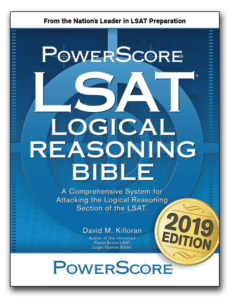Here we give you some useful LSAT Logical Reasoning tips that should help you on your way to mastering the logical reasoning section of the LSAT.
The two LR sections constitute half of your total score on the LSAT, so the work you put in learning to master this section has a big payout.
Your tipmasters, Joshua and Evan, both did very well on logical reasoning (Josh got none wrong on LR, Evan got only one wrong total on the two sections).
Here are some logical reasoning tips that helped us completely dismantle the LSAT logical reasoning section. These are general tips that should apply to the whole section or lots of questions types. Check back on our blog for tips and strategy on specific LR question types.
LSAT LR TIP #1: Read The Question Stimulus First!!!
Doing it the other way and reading the question stem first is like using training wheels to ride a bike. Yes, training wheels keep you upright, but there’s a clear limit to what you can do. Let me show you an example of a moderately difficult LR-type question to show you how reading the stimulus first can help you:
Candidates for Mayor make numerous promises on the campaign trail, always claiming they will do great things for the city, but one must not forget that the candidates’ intention when making these promises is to win the election. Clearly then, these campaign tactics are motivated by self interest and the promises they make during the campaign can’t be considered reliable.
Now if you are an untrained LSAT noob, you might just accept this all this as fact. It does, after all, match up with most people’s view of how politics work.
So then you read on to the question stem, which says: Which one of the following most accurately describes a flaw in the argument above?
Now the LSAT noob is saying to themselves “Oh damn, there’s a flaw in there. Better go and look for it.” The same LSAT noob might further think to themselves, “Wouldn’t I have been better off knowing that I was looking for a flaw right away? Shouldn’t I have read the question stem first?” However this noob, like most noobs, would be wrong.
The right thing to do is to always read the passage carefully before reading the stem. Always be alert for faulty reasoning. The LSAT master reads it carefully and says to himself or herself, “Hold on, that conclusion isn’t necessarily true. Maybe politicians think it’s important to always keep their promises even if they made them just to get elected. In that case, they would be reliable. Also, it’s not even clear that these promises are self-interested. Maybe they want to win election just so they can help people”
To state this all more formally, the experienced LSAT sees that the argument made an unreasonable leap from the fact that campaign promises are designed to win elections to concluding that they are motivated by self-interest and not reliable.
Once they see it, the experienced LSAT master knows absolutely beyond a shred of doubt that the correct answer choice is going to test something related to this flaw.
They know this before reading the question stem. You may not believe me now, but with practice you too will gain this ability.
Let’s look at how a master uses this understanding to answer the question:
Although there are five total answer choices, only two answer choices look tempting, and only one of them is right:
A) The argument presumes, without providing sufficient justification, that promises motivated by self-interest are seldom kept.
B) The argument overlooks that possibility that a promise might be reliable even when the person making the promise has an objective besides merely keeping the promise.
Answer choice A is somewhat attractive, and plays on your emotions. Maybe we think that in real life self-interested people are less likely to keep promises. However, because we read the stimulus first and decided what the flaw is, we know this can’t be the right answer choice.
The flaw in the argument wasn’t asserting that self interested promises are not reliable. The flaw was jumping from the statement that promises are made to win a election to the conclusion that such promises are then both motivated by self interest and not reliable.
Big difference.
Read the stimulus over and over until you see it. Because this answer choice is wrong (it doesn’t describe the flaw), we have to keep looking for an answer that captures something of the flaw that we spotted.
Answer choice B has it.
Though it doesn’t describe the whole flaw, it does give us part of it: Answer choice B is another way of saying that the argument makes the unwarranted assumption that someone making a promise to win a campaign cannot be making a reliable promise.
Yes, it leaves the part about ‘motivated by self-interest’ out, but that doesn’t mean it isn’t the correct answer- no other answer choice describes the flaw at all. This at least describes part of it, and describing part of the flaw is better than nothing at all.
Because you, the future LSAT master, read the stimulus right away and decided what the flaw was before going to the rest of the question, you are more likely to not get distracted by answers that just look plausible.
The added bonus is that it’s easier for you to read the stimulus and spot the flaw if you don’t have some other sentence, the question stem, bouncing around in your head.
Think of it like juggling. Why try to juggle that extra ball when you don’t have to? As you can see in the above example, nothing is gained by reading the stem first.
LSAT LR TIP #2: Get The Best LR Prep Book
This LR tips post you are reading now is short and sweet.
We hope it will give you some key tips you might miss when reading a full prep book.
However, LSAT logical reasoning is an in depth subject.
You need a full book to learn every aspect of the various question types.
Books that cover all three LSAT section types in 400 pages or so aren’t going to fully cover the subject of LSAT logical reasoning.
For that reason, avoid books like Princeton Review’s ‘Cracking The LSAT’, which is still popular for some reason (probably because PR advertises a lot), despite the fact that every LSAT prep expert thinks it’s a piece of junk.
The book we recommend to learn the logical reasoning section is the well-known PowerScore LSAT Logical Reasoning Bible.
Apologies to our regular readers who know our recommendations already, but this is just the best book out there to really master the LR section. It’s over 500 pages of advice, drills, and real LSAT practice questions on just the LR section.
Get it along with the LR Bible Workbook, which gives you even more drills with official LSAT questions. Do these both (it will take about two weeks if you are working quickly) and I promise you’ll see major, major improvements in your LR scores (or if you are just starting out, you’ll know you are getting the proper foundation).
LSAT LR TIP #3: Approach The Questions In Order
On the LR section it’s just going to be a huge waste of time to go around looking for certain questions to do first. Work through each logical reasoning section from front to back in order.
Time is of the essence on the LSAT. Remember that the test is designed so that the average person can’t finish it on time, so you really don’t want to spend any time doing anything besides answering the questions if you can possibly help it.
The LSAT is nice enough to give you the questions in what we consider the ideal order anyways: early questions tend to be easiest, so you get to do them first and warm up to the harder ones later in the section.
LSAT LR TIP #4: Circle Hard Questions To Come Back To Them At The End
As you do an LR section, you might run into some questions that have you stumped (even the best LSATers usually have a couple questions per section that they aren’t sure about on the first pass).
Rather than spin your wheels endlessly on a question, at some point you need to pick the answer that looks best and move on. Circle the question so that you can come back to it at the end of the section if there’s time.
It takes experience to know when it’s time to move on. Yes, the average LR question will take about 1.5 minutes to do, but some questions will go super fast and some are designed to take longer.
My rule of thumb was that if 2.5 minutes had passed on a hard question and I didn’t have an answer, I generally picked the best answer I could quickly and moved on. I found that by doing this I was more likely to have time at the end of the section to come back to that question and any other hard ones.
Surprisingly, these questions often become easier on the second pass when you aren’t stuck in a rut and freaking out.
Even if you don’t get to come back, at least you answered all the questions you could using this approach. Though the questions vary in difficulty, each one is worth the same: one point.
The classic LSAT advice is that you shouldn’t miss out on points from easier questions later in the section by giving way too much time to one hard one. Learn to know when it’s quitting time.
LSAT LR TIP #5: Be Wary of Using Your Own Assumptions To Answer LR Questions
In the LR type question we looked at in tip #1, remember how the argument is basically making the assumption that all politicians are unreliable? Yes we all know that in real life almost all politicians (if not all) fail to deliver on campaign promises.
However, on the LSAT, we can’t bring these assumptions in without questioning them. Even if there hasn’t yet been a reliable politician yet in the world, it’s possible there could be one.
It’s a mistake to assume there can’t be unless the question tells you definitely that no, there can’t be a reliable politician.
Instead of your assumptions, bring your imagination. No this isn’t Barney and Friends. We aren’t going to sing a song about imagination right now.
However, on the LSAT you’ve got to be able to imagine different scenarios that might disprove an argument or provide it support.
In our tip #1 example, imagining that there could be an honest politician or one that is wholly not self-interested helps you see that the argument has made some unwarranted assumptions.
LSAT LR TIP #6: Learn The Precise ‘Logic’ Meaning Of Common Terms On The LSAT
Here I want to talk mostly about two terms that give beginners trouble on the LSAT: ‘some’ and ‘not all’.
Say on the LSAT you are told that “some birds have feathers.”
A lot of people assume that ‘some’ means somewhere in between ‘more than one’ and ‘less than all’. That’s not true.
In logic, ‘some’ might actually mean ‘all’. It also might mean ‘just one’. Likewise, a lot of people don’t realize that ‘not all’ includes the possibility that there are ‘none’.
Yes this doesn’t quite match up with everyday use of the words, but it should make sense when you think about it.
A lot of prep books bury these simple logical definitions somewhere deep in the book, so we wanted to make sure you know these two key ones up front.
Luckily some words aren’t likely to trip you up: “All” really does mean all. “None” really does mean none at all.
Here is a tricky one that gets tested a lot on the LSAT (testing your understanding of the term ‘most’): Say you are told two things: “most birds can fly”, and “also most birds use nests”.
A lot of people don’t realize that you can make an important inference here: at least some birds fly and use nests. Anytime most members of a group have each of two characteristics, at least one member of the group has both these characteristics.
LSAT LR TIP #7: Learn When To Diagram LR Questions
When you start off, you’ll want to diagram just about everything that can be diagrammed (usually that means formal logic. See my post on basic conditional reasoning for the LSAT here).
However, as you get better, you generally save time by diagramming less and less. This is a complicated topic so we’ve written a full post on it: When Should You Diagram LSAT Logical Reasoning Questions?
LSAT LR TIP #8: Check All The Answer Choices
Obviously you should eliminate all answer choices you know are wrong right away, but what happens when you get to one that looks like a sure winner? Should you stop there and circle that as the answer? No.
I can’t tell you how many times on practice tests I thought I had a right answer until I looked at the remaining answer choices and saw another contender. You can’t just sit there and wish that other candidate would go away. You have to do some more work and decide which is best.
The only exception is if you are very pressed for time at the end of the section and only have a few questions left. There, if you see an answer that matches up exactly with what you expected to find, then it’s okay to answer it and forge ahead.
What you should do here is mark the problem with a big star so that you know you haven’t looked at every answer choice. If you have the time, go back and check those remaining answer choices when you get to the end of the section.
Don’t make a habit of this of doing this mid-section. Do it only when you are in a hurry at the end of the section.
LSAT LR TIP #9: Ask Us Questions
We have a lot more advice on process of learning the LR section here: Improving Your Logical Reasoning Score. Also, if you have other logical reasoning questions, both of us are 100% willing to give you free advice to your questions in the comments. We both have seen everything there is to see on the LR section and the LSAT in general, so ask away!
Best of luck!





15 Comments
Hey guys,
Thanks for posting such great advice! I’m about a month into studying, and up until now, I’ve really been focused on logic games. However, now that I’m doing better in that section, I’ve realized I need to spend way more time on logical reasoning, since my score is not moving up. I have 2 months left until my test, so I was wondering if it is still possible for me to go through the LR Bible? Or would my time be better spent doing drills/practice tests at this point?
-Ann
HI Josh,
Similarly to Eric’s post, I’m getting anywhere from 10-12 (!!!) wrong on the LR section after just finishing the course. I’m finding it difficult to keep all of the “rules” for each question type straight. Do you have any tips to approaching these questions? There can be a lot to think about per question type so any study or practice tips are much appreciated.
Thanks!
KT
Hey didn’t find your email on your website. Not sure if this post is too old for you to both to see.
Quick question about the LR & timing. I do great untimed but once timed (only a couple wrong per section) but I get way way more wrong. Any suggestions improve accuracy with time?
Wanted to also add thanks for all the info and such a positive approach to everything!
Hey guys,
Thank you so much for all of your advice on this blog! Just wondering: do you have any last min tips for flaw questions? I started my LSAT studies with getting more than half of the LR questions wrong on each section, but am happy to say that I’ve gotten that number down to 5-6 wrong each section. When I go over those sections though, I find that I’m still getting Flaw questions wrong, particular the more difficult Flaw questions. I find that I pre-phrase pretty well, but have trouble applying my pre-phrase to the abstract concepts presented in the answer choices. Any help would be greatly appreciated!
Thanks, guys — very helpful post for this important part of the test. I was wondering if you could possibly expand on tackling flaw questions (perhaps a brief overview of the most common ones?, i.e. part-to-whole, circular reasoning, etc.) Many thanks in advance.
Hi guys,
Thank you so much for creating this website. Your words of wisdom for the LSAT are very encouraging.
Just wondering, you stated in this blog that in the LSAT we might be tested on the word “most” from something that goes like ““most birds can fly”, and “also most birds use nests”. We can therefore infer that “at least some birds fly and use nests.” If in the LSAT it states something like “some birds can fly” and “some birds use nests,” what can we infer from that? I guess I’m still confused on this “some” usage in the LSAT.
Thank you in advance!
Hi Rina. Some is best thought of as meaning, “at least one”, so if they say “some birds use nests”, that means that at least one bird somewhere is using a nest. It doesn’t have to be anymore than one, but it’s at least one. The other tricky thing is that “some” possibly includes “all.” So the statement “some birds use nests” possibly means that all birds use nests.
If in the LSAT it states “some birds can fly” and “some birds use nests,” you can’t infer anything from that, because there is no overlap. You merely know that at least one bird flies and at least one bird uses nests. Hope this helps.
I have gone through the LR Bible and feel comfortable with conditional logic and most general concepts, but I inevitably miss 4-6 on my practice tests per logical reasoning section, which can mean a large difference in my final score. I feel as though it may be a time issue that I don’t work through the questions as reliably when trying to move quickly, but I am taking the December test which is just a couple of weeks away. Any advice on how to close the gap a little in the home stretch? Would you recommend spending more time on the questions even if I know I won’t have time the last 2-3?
Hi Amy. I wouldn’t quite recommend spending more time on the earlier questions. Instead, really make sure you pay attention to tip 4 here. If it becomes apparent that a question is taking up way too much of your time, consider skipping that one and coming back to it only if you have time (do mark an answer, but move on). This often frees up time for more easily answerable questions, and you may find suddenly that finishing the section accurately is not so difficult. Another strategy that works for a lot of people is skipping parallel reasoning questions, because they are so time consuming. Come back to them at the end if there is time.
It sounds like you’ve done a great job so far. Keep your confidence levels high and you should be in good shape!
Amy,
Here are a few things that you might consider trying:
Hey Josh,
I’ve gone through the LG bible and usually only miss one or two per games section. However, I’m nearly halfway through the LR bible and I don’t know if I’m just misunderstanding the techniques or what? I feel like I understand the stimulus and what not but I still miss nearly 40%-50% of my LR questions which is killing my score. Do I just need more practice? How do I know if I’m actually approaching the questions correctly if I continue to miss them? Thank you for any help you can provide!
Ethan, if you are missing that many you likely have some fundamental problems with conditional logic and making inferences. Really focus on the conditional logic section of the LR bible and also the must be true questions. Also, do LR untimed for a while (even for the next month is okay) to build accuracy before you add the timing component. Don’t look at the answer to a problem until you can describe why you are choosing a certain answer and why the other choices are inferior.
Hey Josh.
Many thanks for your contributions to making the LSAT seem beatable.
My questions is: How do you keep yourself from not getting too discouraged early on in your performance? I just got done “learning the ropes” through the books and still seem to be getting -10 on each LR sections. I’d review them shortly after and notice what I did wrong, but it is still discouraging nonetheless.
Any tips?
Thanks
Hey Eric, sorry I nearly missed this comment. The thing to realize is that you aren’t going to see improvements until the techniques really sink in. It’s best to think of LSAT logical reasoning skills like sports skills- you can have someone tell you all day to cock your wrist the right way on a golf swing, but you won’t become good at it until you go out and do the swing that way 1,000 times. It’s the same thing on the LSAT.
Everyone gets discouraged at some point in their studies. Realize that you haven’t taken the actual test yet. No one is grading you on your practice. Keep at it and you WILL see improvements. Everyone is capable of improving significantly from their cold diagnostic score.